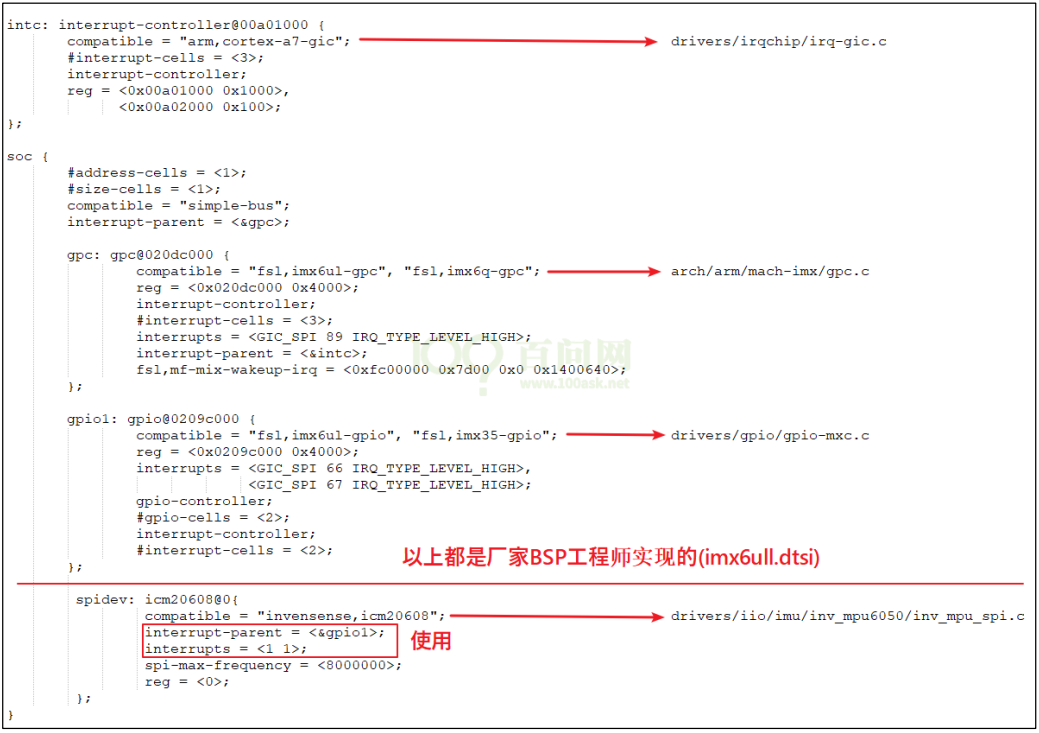# 前置知识
interrupts
文档
Specifying interrupt information for devices
============================================1) Interrupt client nodes
-------------------------Nodes that describe devices which generate interrupts must contain an
"interrupts" property, an "interrupts-extended" property, or both. If both are
present, the latter should take precedence; the former may be provided simply
for compatibility with software that does not recognize the latter. These
properties contain a list of interrupt specifiers, one per output interrupt. The
format of the interrupt specifier is determined by the interrupt controller to
which the interrupts are routed; see section 2 below for details.Example:interrupt-parent = <&intc1>;interrupts = <5 0>, <6 0>;The "interrupt-parent" property is used to specify the controller to which
interrupts are routed and contains a single phandle referring to the interrupt
controller node. This property is inherited, so it may be specified in an
interrupt client node or in any of its parent nodes. Interrupts listed in the
"interrupts" property are always in reference to the node's interrupt parent.The "interrupts-extended" property is a special form for use when a node needs
to reference multiple interrupt parents. Each entry in this property contains
both the parent phandle and the interrupt specifier. "interrupts-extended"
should only be used when a device has multiple interrupt parents.Example:interrupts-extended = <&intc1 5 1>, <&intc2 1 0>;2) Interrupt controller nodes
-----------------------------A device is marked as an interrupt controller with the "interrupt-controller"
property. This is a empty, boolean property. An additional "#interrupt-cells"
property defines the number of cells needed to specify a single interrupt.It is the responsibility of the interrupt controller's binding to define the
length and format of the interrupt specifier. The following two variants are
commonly used:a) one cell-----------The #interrupt-cells property is set to 1 and the single cell defines theindex of the interrupt within the controller.Example:vic: intc@10140000 {compatible = "arm,versatile-vic";interrupt-controller;#interrupt-cells = <1>;reg = <0x10140000 0x1000>;};sic: intc@10003000 {compatible = "arm,versatile-sic";interrupt-controller;#interrupt-cells = <1>;reg = <0x10003000 0x1000>;interrupt-parent = <&vic>;interrupts = <31>; /* Cascaded to vic */};b) two cells------------The #interrupt-cells property is set to 2 and the first cell defines theindex of the interrupt within the controller, while the second cell is usedto specify any of the following flags:- bits[3:0] trigger type and level flags1 = low-to-high edge triggered2 = high-to-low edge triggered4 = active high level-sensitive8 = active low level-sensitiveExample:i2c@7000c000 {gpioext: gpio-adnp@41 {compatible = "ad,gpio-adnp";reg = <0x41>;interrupt-parent = <&gpio>;interrupts = <160 1>;gpio-controller;#gpio-cells = <1>;interrupt-controller;#interrupt-cells = <2>;nr-gpios = <64>;};sx8634@2b {compatible = "smtc,sx8634";reg = <0x2b>;interrupt-parent = <&gpioext>;interrupts = <3 0x8>;#address-cells = <1>;#size-cells = <0>;threshold = <0x40>;sensitivity = <7>;};};
简要说明
节点属性:
- interrupts // 表示要使用哪一个中断, 中断的触发类型等等。
- interrupt-parent // 这个中断要接到哪一个设备去? 即父中断控制器是谁
- interrupt-controller; // 表示自己是一个中断控制器
- #interrupt-cells // 表示自己的子设备里应该用几个U32的数据来描述中断
举例:
# 在Linux使用gpio子系统
https://www.cnblogs.com/schips/p/linux_subsystem_using_gpio_ss.html![]() https://www.cnblogs.com/schips/p/linux_subsystem_using_gpio_ss.html
https://www.cnblogs.com/schips/p/linux_subsystem_using_gpio_ss.html









)







——半导体导电特性)


